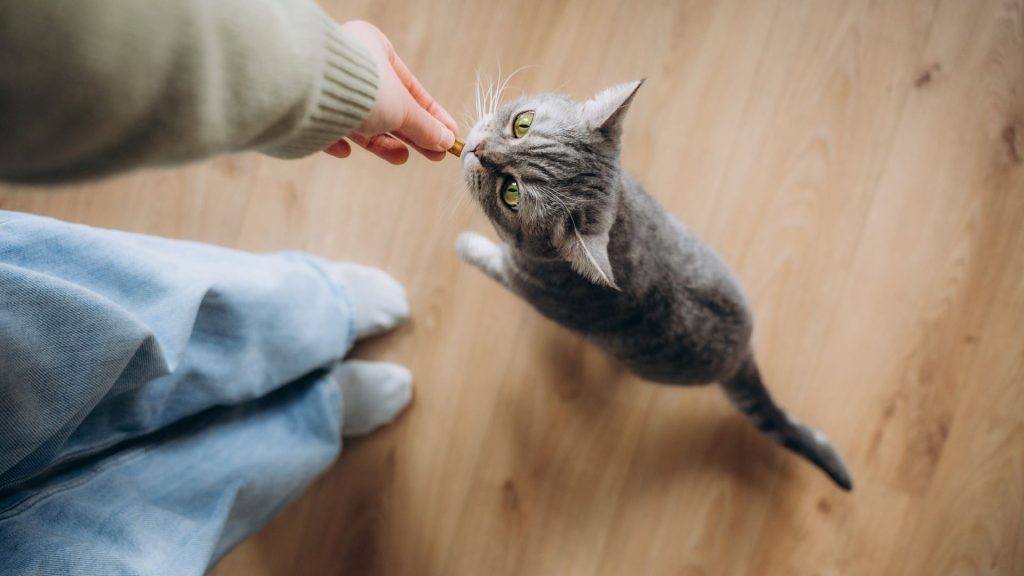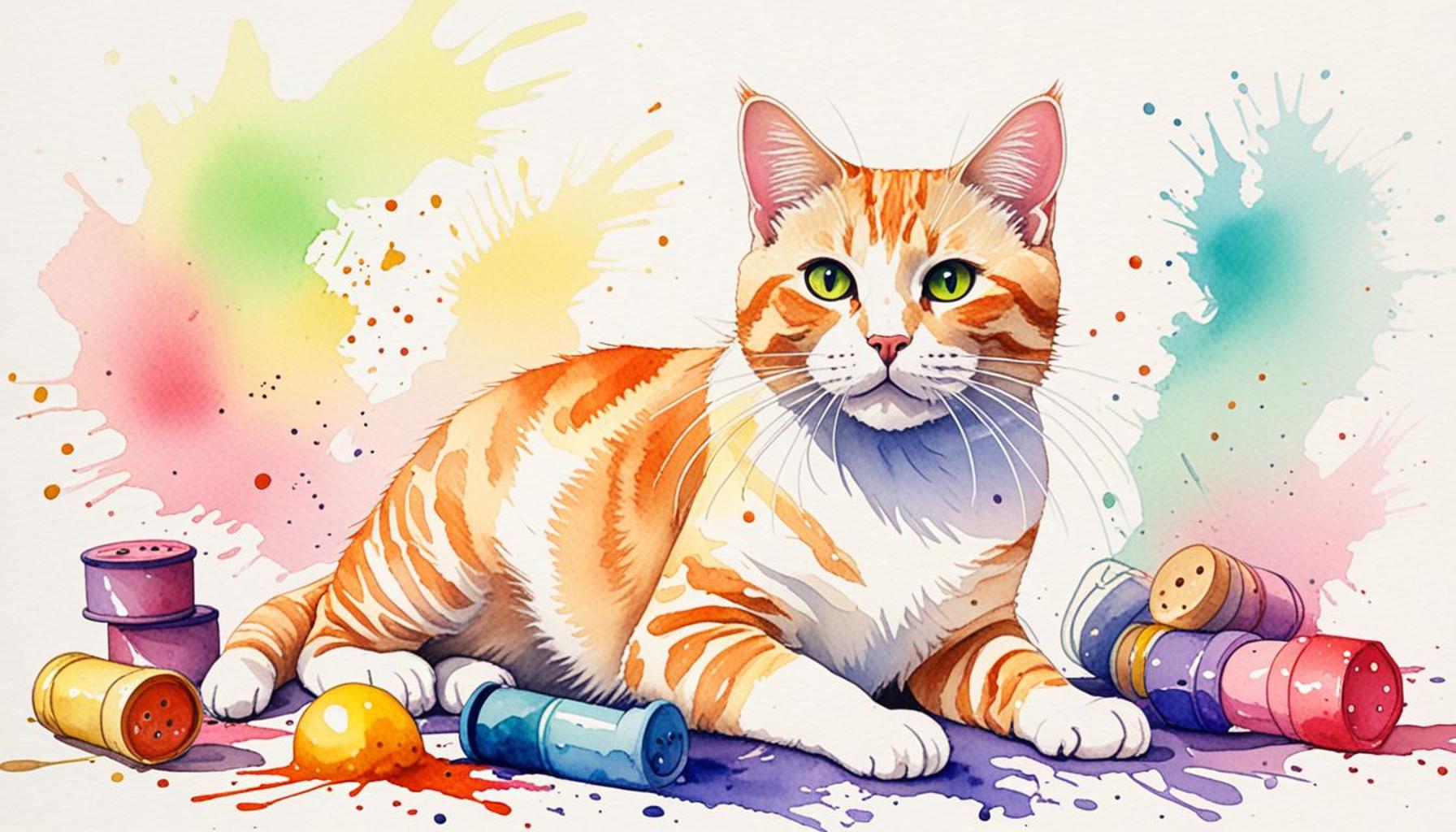Positive Reinforcement Strategies for Training Cats: Creating a Comfortable Learning Environment

Understanding Positive Reinforcement in Cat Training
Training your cat can be a rewarding journey filled with joy and companionship. Utilizing positive reinforcement strategies transforms this process into a fun and effective experience for both owner and pet. By creating a comfortable learning environment, you can facilitate better communication and trust between you and your feline friend.
Why Choose Positive Reinforcement?
Positive reinforcement focuses on rewarding desired behaviors rather than punishing unwanted ones. This method aligns with how cats naturally learn, promoting a harmonious relationship between you and your cat. Here are some key benefits:
- Encourages Good Behavior: Cats are more likely to repeat actions that result in a positive outcome. For instance, if your cat sits on command and receives a treat, it learns to associate sitting with a reward, increasing the likelihood of that behavior being repeated.
- Reduces Stress: Using praise and treats creates a calm atmosphere, making learning less intimidating. Unlike punishment-based techniques that can lead to fear or anxiety, positive reinforcement fosters confidence in your pet.
- Strengthens Bonds: Sharing pleasurable moments through training enhances your relationship. Training sessions can transform into enjoyable bonding experiences where both you and your cat look forward to interacting.
With the right approach, your cat can learn essential commands, improve manners, and even perform tricks like high-fives or rolling over. Getting started requires some understanding of feline behavior and a few fundamental strategies to create an inviting atmosphere.
Creating a Comfortable Learning Environment
An optimal learning space can make all the difference in your cat’s training process. Here are some strategies to consider:
- Minimize Distractions: Choose a quiet space away from loud noises or other pets. A stress-free environment allows your cat to focus better on the training tasks at hand.
- Use High-Value Treats: Find your cat’s favorites to keep them motivated. This might include small bits of chicken, fish, or specifically formulated cat treats. The more enticing the reward, the more engaged your cat will be.
- Be Patient: Progress takes time; celebrating small victories fosters confidence. For example, if your cat learns to use the litter box properly, celebrating that success encourages future good behavior. Remember, patience is key in reinforcing positive habits.
Exploring these strategies will not only enhance your training sessions but also lead to a deeper understanding of your furry companion. Additionally, consider keeping a training journal to track progress and reflect on what techniques work best for your cat. As you delve into this method of training, you will likely uncover new insights into the unique personality of your pet. Ready to embark on this delightful journey? Let’s discover the world of positive reinforcement for cat training!

DON’T MISS OUT: Click here for essential puppy training tips
Key Elements of a Successful Training Session
The essence of effective cat training lies in understanding the key elements that contribute to a successful session. Each cat is unique in their personality and learning style; therefore, tailoring your approach is vital. Here are some fundamental aspects to consider:
Establish a Routine
Much like humans, cats thrive on routine. Regular training sessions help your cat understand expectations and develop a sense of familiarity. Aim for a consistent time and place for training, which will allow your cat to anticipate and prepare for these moments. Short sessions of about 5 to 10 minutes are ideal, as cats have shorter attention spans compared to dogs. This frequency in training can be more effective than long, sporadic sessions.
Choose the Right Time
Timing is everything when it comes to capturing your cat’s attention. Choose a time when your cat is naturally more alert and active. For many felines, this is often during the early morning or late afternoon. Training them during these times increases their engagement and receptiveness to learning.
Use Clear and Consistent Cues
Creating clear communication is another essential element of positive reinforcement. Employ specific cues such as verbal commands and hand signals consistently. For instance, if you say “sit,” always use that exact phrase and the same body language to reinforce your message. Cats are perceptive and will pick up on these cues over time, making it easier for them to understand what is expected of them.
Rewards are Key
Rewarding your cat for their efforts is at the heart of positive reinforcement. Recognizing good behavior—whether it’s sitting on command or using the scratching post—can be done through immediate rewards. These can include treats, playtime, or affectionate praise. The key here is to provide the reward the moment the behavior occurs, helping your cat make the connection between their action and the reward. Here are some types of rewards to keep in mind:
- Treats: Small, tasty morsels can rapidly motivate your cat. Look for treats free from artificial ingredients and specifically made for feline palates.
- Playtime: Many cats are highly responsive to interactive play. Engage them with a favorite toy, such as a feather wand or laser pointer, as a reward.
- Affection: Never underestimate the power of a good scratch behind the ears or a gentle cuddle. For some cats, affection can be the most rewarding experience.
Incorporating these essential elements into your training regimen will significantly enhance your cat’s learning experience. As you follow these guidelines, remember that every small step towards mastering a behavior is progress. Building on these foundational strategies can produce not only a well-trained cat but also a fulfilling relationship between you and your furry companion.
Positive Reinforcement Techniques
When it comes to training cats, utilizing positive reinforcement strategies can be incredibly effective. These methods focus on rewarding desirable behaviors, rather than punishing undesirable ones. This creates a comfortable learning environment where your feline friend feels secure and motivated to engage. Through various approaches such as treats, praise, or playtime, you can build strong communication with your cat, encouraging them to repeat positive behaviors. Key strategies include:
- Clicker Training: This method involves using a clicker to mark the exact moment a desired behavior occurs, followed by a reward. This positive association helps your cat understand what actions earn them a treat.
- Treat Rewards: Always have a selection of high-value treats available. Offering a small piece of their favorite food can significantly motivate your cat to learn.
- Play-Based Training: Incorporate toys that stimulate your cat’s hunting instincts. By playing with a wand toy or laser pointer, you can reward your cat’s natural behaviors while integrating training commands.
By fostering an engaging atmosphere that emphasizes fun and rewards, you enhance not only your cat’s learning experience but also the bond you share. Consistency is essential; gradual progress builds confidence in your cat and encourages them to explore new skills. To delve deeper into the advantages of these techniques, consider evaluating your specific home environment and your cat’s individual preferences. Every cat is unique and can respond differently to various stimulation methods!
| Advantages | Description |
|---|---|
| Promotes Positive Behavior | Encourages cats to repeat good behavior through rewards. |
| Builds Trust | Enhances the bond between cat and owner through positive interactions. |
Implementing these positive reinforcement strategies not only shapes your cat’s behavior but also ensures a happier atmosphere. With time and practice, your cat will blossom into a well-mannered companion.
LEARN MORE: Click here for effective training tips
Creating an Optimal Learning Environment
Beyond the practical elements of training, the environment in which you train your cat plays a crucial role in their learning process. A well-structured and comfortable learning environment can significantly enhance your cat’s receptiveness and willingness to engage. Here are some vital aspects to consider when creating the ideal setting for your training sessions:
Minimize Distractions
Cats can be easily distracted by noises, objects, or other animals. To facilitate optimal focus, it’s essential to minimize distractions during training sessions. Choose a quiet room far from loud appliances, television, or any bustling activities. If your cat is easily distracted by other pets, consider training in a space where they can feel secure and undisturbed. This ensures that their attention remains solely on you and the tasks at hand.
Utilize Familiar Surroundings
Kids often learn best in environments where they feel safe and secure, and the same can be said for cats. Conduct training sessions in areas where your cat feels most comfortable, whether it’s their favorite blanket, the sunlit spot by the window, or a cozy corner of the living room. Associating training with familiar spaces can make the experience less intimidating and help reduce any stress your feline friend may feel.
Incorporate Enrichment Activities
In addition to training, integrating enrichment activities can stimulate your cat’s mind and enhance their learning experience. This might include puzzle feeders, scratching posts, or interactive toys that encourage problem-solving and play. Providing these activities between training sessions can help maintain your cat’s interest and motivation. Remember, a mentally engaged cat is more likely to be receptive to positive reinforcement and learn effectively.
Monitor Your Cat’s Body Language
Your cat’s body language can often speak volumes about their comfort level during training. Pay attention to signs of stress or disinterest, such as tail flicking, ears pinned back, or attempts to escape. It’s essential to adjust your approach based on their body language. If your cat seems overwhelmed, take a step back; this could mean reducing session duration or taking a break altogether. Positive reinforcement is most effective when the cat is comfortable and willing to participate.
Consider Using a Training Clicker
Another effective tool to enhance your cat’s training is a clicker. This small device emits a distinct sound that can mark the exact moment your cat exhibits the desired behavior, thereby reinforcing the connection between the action and the reward. A clicker can help improve communication and timing, which are critical to successful positive reinforcement. Pair the clicker with treats immediately after clicking, so your cat learns that the sound means a reward is on the way.
Establishing an adaptable training environment, coupled with keen observation of your cat’s reactions, offers a nurturing atmosphere for learning. By creating a less intimidating setting and utilizing various tools and techniques, you’ll pave the way for a more engaging and effective training experience. This not only fosters good behavior but strengthens the bond you share with your feline companion.
LEARN MORE: Click here to discover essential tips
Conclusion
In summary, effective positive reinforcement strategies for training cats hinge significantly on the environment you create. By understanding and implementing techniques that foster a comfortable and engaging atmosphere, you not only enhance your cat’s learning experience but also strengthen the bond you share. For instance, a quiet corner of your home, free from distractions, can serve as an ideal training space. Cats are naturally curious creatures, so their environment plays a pivotal role in their ability to focus. When they feel at ease, they are more likely to engage with the training process.
Incorporating enrichment activities into your cat’s routine can further stimulate their minds. Activities such as puzzle feeders or interactive toys not only encourage play but also develop problem-solving skills. Additionally, observing and being mindful of your cat’s body language can be key to a successful training session. Signs of stress, such as flattened ears or a twitching tail, indicate that your cat may need a break or a different approach. Training should always be a positive experience without adding undue pressure.
The incorporation of tools like a clicker further elevates your training sessions, allowing for precise communication and aiding in reinforcing desired behaviors effectively. This handheld device produces a distinct sound that serves as an immediate mark for the desired action, effectively helping your cat associate the click with a reward. As you embark on this journey of training your cat, remember that patience is key. Every cat learns at their own pace, and flexibility in your approach will yield the best results.
It’s beneficial to explore various resources on feline behavior and training techniques. Books, online courses, and local workshops can provide you with new insights and methods to improve your approach. For example, engaging with communities focused on animal training can deepen your understanding and open avenues to share experiences with fellow cat owners. By continuously educating yourself, you equip yourself with better tools and insights, paving the way for a harmonious partnership with your beloved pet.



